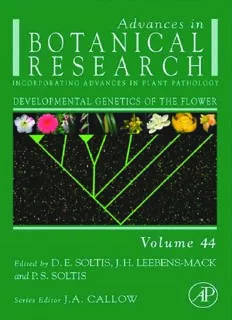
Developmental Genetics of the Flower PDF
Preview Developmental Genetics of the Flower
Advances in BOTANICAL RESEARCH Incorporating Advances in Plant Pathology VOLUME 44 DEVELOPMENTAL GENETICS OF THE FLOWER Advances in BOTANICAL RESEARCH Incorporating Advances in Plant Pathology Editor-in-Chief J. A. CALLOW School of Biosciences, The University of Birmingham, Birmingham, United Kingdom Editorial Board J. S. HESLOP-HARRISON University of Leicester, United Kingdom M. KREIS Universite de Paris-Sud, Orsay, France R. A. LEIGH University of Cambridge, Cambridge, United Kingdom P. R. SHEWRY IACR-Long Ashton Research Station, United Kingdom D. E. SOLTIS University of Florida at Gainesville, USA Advances in BOTANICAL RESEARCH Incorporating Advances in Plant Pathology DEVELOPMENTAL GENETICS OF THE FLOWER Edited by DOUGLAS E. SOLTIS DepartmentofBotany, University ofFlorida, Gainesville, Florida, United States JAMES H. LEEBENS-MACK DepartmentofPlant Biology, The University of Georgia,Athens, Georgia, UnitedStates PAMELA S. SOLTIS Florida MuseumofNatural History, University ofFlorida, Gainesville, Florida, UnitedStates Series Editor J. A. CALLOW Schoolof Biosciences, University ofBirmingham, Birmingham, UnitedKingdom VOLUME 44 2006 AMSTERDAM • BOSTON (cid:127) HEIDELBERG (cid:127) LONDON NEW YORK (cid:127) OXFORD (cid:127) PARIS (cid:127) SAN DIEGO SAN FRANCISCO (cid:127) SINGAPORE (cid:127) SYDNEY (cid:127) TOKYO Academic Press is an imprint of Elsevier AcademicPressisanimprintofElsevier 525BStreet,Suite1900,SanDiego,California92101-4495,USA 84Theobald’sRoad,LondonWC1X8RR,UK Thisbookisprintedonacid-freepaper. Copyright(cid:1)2006,ElsevierLtd.AllRightsReserved. Nopartofthispublicationmaybereproducedortransmittedinanyformorbyany means,electronicormechanical,includingphotocopy,recording,oranyinformation storageandretrievalsystem,withoutpermissioninwritingfromthePublisher. Theappearanceofthecodeatthebottomofthefirstpageofachapterinthisbook indicatesthePublisher’sconsentthatcopiesofthechaptermaybemadefor personalorinternaluseofspecificclients.Thisconsentisgivenonthecondition, however,thatthecopierpaythestatedpercopyfeethroughtheCopyrightClearance Center,Inc.(www.copyright.com),forcopyingbeyondthatpermittedby Sections107or108oftheU.S.CopyrightLaw.Thisconsentdoesnotextendto otherkindsofcopying,suchascopyingforgeneraldistribution,foradvertising orpromotionalpurposes,forcreatingnewcollectiveworks,orforresale. Copyfeesforpre-2006chaptersareasshownonthetitlepages.Ifnofeecode appearsonthetitlepage,thecopyfeeisthesameasforcurrentchapters. 0065-2296/2006$35.00 PermissionsmaybesoughtdirectlyfromElsevier’sScience&TechnologyRights DepartmentinOxford,UK:phone:(þ44)1865843830,fax:(þ44)1865853333, E-mail:[email protected] viatheElsevierhomepage(http://elsevier.com),byselecting‘‘Support&Contact’’ then‘‘CopyrightandPermission’’andthen‘‘ObtainingPermissions.’’ ForinformationonallAcademicPresspublications visitourWebsiteatwww.books.elsevier.com ISBN-13:978-0-12-005944-7 ISBN-10:0-12-005944-4 PRINTEDINTHEUNITEDSTATESOFAMERICA 06 07 08 09 9 8 7 6 5 4 3 2 1 CONTENTS CONTRIBUTORSTOVOLUME44 .......................................... xi CONTENTSOFVOLUMES34–43............................................ xv Angiosperm Floral Evolution: Morphological Developmental Framework PETER K. ENDRESS I. Introduction........................................................... 2 II. Development:FromFloralPrimordiumtoFlower—Contingencyofthe PrimaryMorphologicalSurface.......................................... 4 III. Evolution:FromSimpletoComplexFlowers—Contingencyofthe DevelopmentalProgram ................................................ 6 IV. FloralOrgansasModules,OrganCategories(OrganIdentity),and TheirEvolution........................................................ 7 V. FloralPhyllotaxis...................................................... 15 VI. FloralSymmetry....................................................... 20 VII. Angiospermy:CarpelClosureandModesofSealing ........................ 23 VIII. PostgenitalCoherence .................................................. 25 IX. Synorganization ....................................................... 26 X. PlasticityofOrganForminDevelopmentShapedbyFloralArchitecture orbyContiguousParts................................................. 35 XI. ArchitecturalExtremes.................................................. 37 XII. AnInnovationofFlexibility:EscapefromConstraintsofSynorganized FlowersinCoreEudicots—IncreaseofStamenNumberandDecouplingof SequenceofInitiationofStamensandCarpelsbyRingMeristems............ 39 XIII. PotentialPitfallsofGeneralizationsfromModelPlants...................... 43 XIV. ConclusionsandQuestions.............................................. 45 References............................................................ 46 Recent Developments Regarding the Evolutionary Origin of Flowers MICHAEL W. FROHLICH I. Introduction........................................................... 64 II. WhatNeedstoBeExplainedfortheOriginoftheFlower?................... 71 III. ImportantAttributesoftheAncestralFlower.............................. 74 IV. WhatShouldaTheoryDo? ............................................. 77 V. TheAnthophyteTheory ................................................ 78 VI. MolecularPhylogeneticAnalysesofSeedPlantsUnderminethe AnthophyteTheory .................................................... 79 VII. TheMostlyMaleTheory................................................ 95 vi CONTENTS VIII. AlternativesandModificationsoftheMostlyMaleTheory................... 104 IX. BaumandHileman’sScenarioforFlowerOrigins........................... 107 X. Doyle’sCaytonia–GlossopteridModelfortheOriginoftheCarpel ............ 108 XI. Meyen’sGametoheterotopyTheory(andKrassilov’s(1997)Book)............. 110 XII. DoubleFertilizationandFriedmanandWilliams’ModularScenario........... 112 XIII. OverallConclusions..................................................... 116 References............................................................. 116 Duplication, Diversification, and Comparative Genetics of Angiosperm MADS-Box Genes VIVIAN F. IRISH I. Introduction........................................................... 130 II. RationaleforExploringMADS-BoxGeneDiversification.................... 131 III. FlowerMorphologiesAcrosstheAngiosperms.............................. 132 IV. PerianthDiversityAcrosstheMajorCladesofAngiosperms.................. 135 V. HowDidtheGeneticMechanismsControllingTheseNew MorphologiesEvolve?................................................... 136 VI. EvolutionofAP3andPIFunction........................................ 147 VII. HowDoWeFunctionallyAnalyzeMADS-BoxGenesinNonmodelSpecies? ... 148 VIII. Prospects.............................................................. 150 References............................................................. 151 Beyond the ABC-Model: Regulation of Floral Homeotic Genes LAURA M. ZAHN, BAOMIN FENG AND HONG MA I. Introduction:TheABC-Model ........................................... 164 II. RegulatorsofA-Function ............................................... 170 III. RegulatorsofB-Function................................................ 173 IV. RegulatorsofC-Function................................................ 181 V. SummaryandPerspectives............................................... 194 References............................................................. 196 Missing Links: DNA-Binding and Target Gene Specificity of Floral Homeotic Proteins RAINER MELZER, KERSTIN KAUFMANN AND GU¨NTER THEIßEN I. Introduction........................................................... 210 II. BindingofMADS-DomainProteinstoDNA............................... 211 III. LearningfromHomeodomainProteinsinAnimals.......................... 214 IV. CArGGalore:WhatFor? ............................................... 216 V. DNABending ......................................................... 217 CONTENTS vii VI. DoestheProteinConcentrationMatter?................................... 219 VII. Protein–ProteinInteractions:ElectiveAffinities............................. 221 VIII. TargetGenes:HintsforTargetGeneSpecificity?........................... 227 IX. EvolutionaryImplications:NothingintheMADSWorldMakesSenseExcept intheLightofTargetGeneSpecificity.................................... 228 References............................................................ 230 Genetics of Floral Development in Petunia ANNEKE RIJPKEMA, TOM GERATS AND MICHIEL VANDENBUSSCHE I. Introduction........................................................... 238 II. TheTransitiontoFlowering............................................. 243 III. MeristemIdentityGenes:InflorescenceandFlowerArchitecture.............. 247 IV. FloralOrganIdentityDetermination...................................... 251 V. Conclusions........................................................... 268 References............................................................ 270 Flower Development: The Antirrhinum Perspective BRENDAN DAVIES, MARIA CARTOLANO AND ZSUZSANNA SCHWARZ-SOMMER I. Introduction........................................................... 280 II. TheControlofFloralIdentity:WheretheDifferencesBegin ................. 281 III. The(A)BC-Model:PastDiscoveriesandCurrentProblems................... 282 IV. InflorescenceandFloralArchitecture..................................... 298 V. FloralSymmetry....................................................... 303 VI. FloralColor,Scent,andCellShape:TheSkillsofAntirrhinumto AttractPollinators ..................................................... 308 VII. Outlook .............................................................. 312 References............................................................ 315 Floral Developmental Genetics of Gerbera (Asteraceae) TEEMU H. TEERI, MIKA KOTILAINEN, ANNE UIMARI, SATU RUOKOLAINEN, YAN PENG NG, URSULA MALM, EIJA PO¨LLA¨NEN, SUVI BROHOLM, ROOSA LAITINEN, PAULA ELOMAA AND VICTOR A. ALBERT I. Introduction........................................................... 324 II. GerberaMADS-BoxGenes.............................................. 331 III. GerberaGenomics...................................................... 343 viii CONTENTS IV. TheGerberaCapitulum ................................................. 344 V. Conclusions ........................................................... 347 References............................................................. 347 Gene Duplication and Floral Developmental Genetics of Basal Eudicots ELENA M. KRAMER AND ELIZABETH A. ZIMMER I. Introduction........................................................... 354 II. EvolutionandMorphologyoftheEudicots ................................ 354 III. GeneticsofFloralOrganIdentityinModelSpecies.......................... 357 IV. GeneDuplicationsWithintheBasalEudicotGrade ......................... 362 V. GeneDuplicationsintheEarlyBranchesoftheEudicotRadiation: TheRanunculales ...................................................... 373 VI. Summary.............................................................. 375 References............................................................. 376 Genetics of Grass Flower Development CLINTON J. WHIPPLE AND ROBERT J. SCHMIDT I. Introduction........................................................... 386 II. GrassFloralMorphology................................................ 388 III. GeneticsofGrassFlowerDevelopment.................................... 390 IV. PhysicalInteractionsamongMADS-BoxProteins:FunctionandEvolution..... 404 V. TheGrassFamilyasaModelSystemforEvo-Devo......................... 408 VI. Conclusions ........................................................... 415 References............................................................. 417 Developmental Gene Evolution and the Origin of Grass Inflorescence Diversity SIMON T. MALCOMBER, JILL C. PRESTON, RENATA REINHEIMER, JESSIE KOSSUTH AND ELIZABETH A. KELLOGG I. Introduction........................................................... 426 II. Methods .............................................................. 434 III. MorphologicalVariationandMolecularEvolutionofGenesin GrassInflorescences .................................................... 437 IV. Conclusions ........................................................... 468 References............................................................. 472 CONTENTS ix Expression of Floral Regulators in Basal Angiosperms and the Origin and Evolution of ABC-Function PAMELA S. SOLTIS, DOUGLAS E. SOLTIS, SANGTAE KIM, ANDRE CHANDERBALI AND MATYAS BUZGO I. Introduction........................................................... 484 II. SummaryoftheABC-Model ............................................ 485 III. AlternativestotheABC-Model.......................................... 486 IV. ExpressionofFloralRegulatorsinBasalAngiosperms ...................... 489 V. CorrespondenceBetweenExpressionPatternsandFloralMorphology......... 493 VI. NewInsightsintotheEvolutionofNovelFloralStructures.................. 494 VII. DerivationoftheABC-Model ........................................... 495 VIII. FutureDirections...................................................... 496 IX. Conclusions........................................................... 498 References............................................................ 502 The Molecular Evolutionary Ecology of Plant Development: Flowering Time in Arabidopsis thaliana KATHLEEN ENGELMANN AND MICHAEL PURUGGANAN I. Introduction........................................................... 508 II. EvolutionaryEcologyofFloweringTime.................................. 508 III. TheGeneticBasisofEnvironmentalPerceptioninFloweringTimeSignaling... 512 IV. QuantitativeTraitLocusMappingofFloweringTimeVariation.............. 514 V. IsolationofGenesUnderlyingFloweringTimeVariation.................... 516 VI. MicroevolutionofFloweringTimeLoci................................... 518 VII. Summary............................................................. 521 References............................................................ 521 A Genomics Approach to the Study of Ancient Polyploidy and Floral Developmental Genetics JAMES H. LEEBENS-MACK, KERR WALL, JILL DUARTE, ZHENGUI ZHENG, DAVID OPPENHEIMER AND CLAUDE DEPAMPHILIS I. Introduction........................................................... 528 II. WidespreadPolyploidyinAngiospermHistory............................. 531 III. ImplicationsofAncientPolyploidyforComparativeGenomics............... 533 IV. ComparativeAnalysesofDistantlyRelatedTaxaElucidate GeneFunctioninArabidopsis............................................ 539
Description: